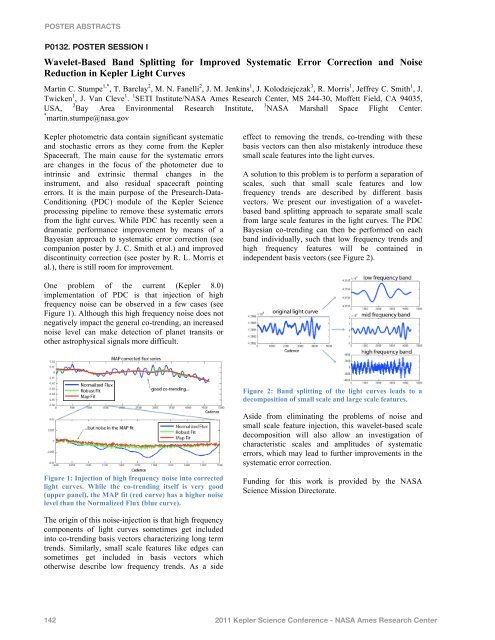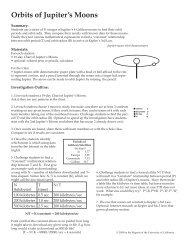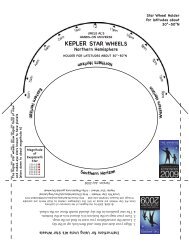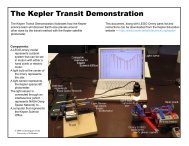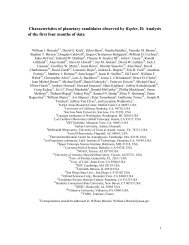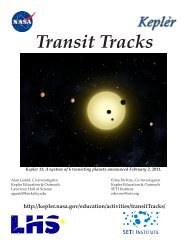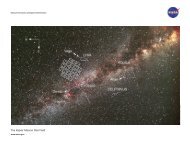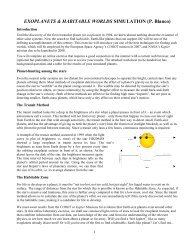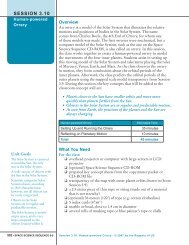Poster Abstracts - Kepler - NASA
Poster Abstracts - Kepler - NASA
Poster Abstracts - Kepler - NASA
- No tags were found...
Create successful ePaper yourself
Turn your PDF publications into a flip-book with our unique Google optimized e-Paper software.
POSTER ABSTRACTSP0132. POSTER SESSION IWavelet-Based Band Splitting for Improved Systematic Error Correction and NoiseReduction in <strong>Kepler</strong> Light CurvesMartin C. Stumpe 1,* , T. Barclay 2 , M. N. Fanelli 2 , J. M. Jenkins 1 , J. Kolodziejczak 3 , R. Morris 1 , Jeffrey C. Smith 1 , J.Twicken 1 , J. Van Cleve 1 . 1 SETI Institute/<strong>NASA</strong> Ames Research Center, MS 244-30, Moffett Field, CA 94035,USA,2 Bay Area Environmental Research Institute,3 <strong>NASA</strong> Marshall Space Flight Center.* martin.stumpe@nasa.gov<strong>Kepler</strong> photometric data contain significant systematicand stochastic errors as they come from the <strong>Kepler</strong>Spacecraft. The main cause for the systematic errorsare changes in the focus of the photometer due tointrinsic and extrinsic thermal changes in theinstrument, and also residual spacecraft pointingerrors. It is the main purpose of the Presearch-Data-Conditioning (PDC) module of the <strong>Kepler</strong> Scienceprocessing pipeline to remove these systematic errorsfrom the light curves. While PDC has recently seen adramatic performance improvement by means of aBayesian approach to systematic error correction (seecompanion poster by J. C. Smith et al.) and improveddiscontinuity correction (see poster by R. L. Morris etal.), there is still room for improvement.effect to removing the trends, co-trending with thesebasis vectors can then also mistakenly introduce thesesmall scale features into the light curves.A solution to this problem is to perform a separation ofscales, such that small scale features and lowfrequency trends are described by different basisvectors. We present our investigation of a waveletbasedband splitting approach to separate small scalefrom large scale features in the light curves. The PDCBayesian co-trending can then be performed on eachband individually, such that low frequency trends andhigh frequency features will be contained inindependent basis vectors (see Figure 2).One problem of the current (<strong>Kepler</strong> 8.0)implementation of PDC is that injection of highfrequency noise can be observed in a few cases (seeFigure 1). Although this high frequency noise does notnegatively impact the general co-trending, an increasednoise level can make detection of planet transits orother astrophysical signals more difficult.Figure 2: Band splitting of the light curves leads to adecomposition of small scale and large scale features.Aside from eliminating the problems of noise andsmall scale feature injection, this wavelet-based scaledecomposition will also allow an investigation ofcharacteristic scales and amplitudes of systematicerrors, which may lead to further improvements in thesystematic error correction.Figure 1: Injection of high frequency noise into correctedlight curves. While the co-trending itself is very good(upper panel), the MAP fit (red curve) has a higher noiselevel than the Normalized Flux (blue curve).Funding for this work is provided by the <strong>NASA</strong>Science Mission Directorate.The origin of this noise-injection is that high frequencycomponents of light curves sometimes get includedinto co-trending basis vectors characterizing long termtrends. Similarly, small scale features like edges cansometimes get included in basis vectors whichotherwise describe low frequency trends. As a side1422011 <strong>Kepler</strong> Science Conference - <strong>NASA</strong> Ames Research Center


